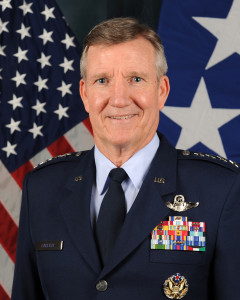
Air Combat Command latest DoD component to warn against shutdown
Gen. Herbert Carlisle says his troops are burnt out and his resources can barely cover the global demand. Carlisle becomes the third senior DoD official this week...
The leader of Air Combat Command says he is on the “ragged edge” of being able to consistently deliver air power and surveillance to meet global needs.
Gen. Herbert Carlisle said his pilots are burnt out from the amount of deployments and lack of personnel capacity now that the Air Force is the smallest it has been since its creation in 1947.
Carlisle’s comments during a Sept. 18 speech at the Center for Strategic and International Studies (CSIS) come at a time when the Defense Department is facing a potential $40 billion cut in the fiscal 2016 budget, if Congress cannot come to a budget deal by the end of the month.

“I have a very difficult time meeting the demands of the combatant commanders across the globe,” said Carlisle, who command controls all bombers, fighters, reconnaissance and air training. “If you think about our ability to react to what happened in Nepal, at the same time we are dealing with failed states in Libya and Yemen, at the same time we are dealing with [the Islamic State group] and the counterterrorism fight, the fighting season in Afghanistan, Crimea and Eastern Ukraine, the potential of supporting our friends and allies in the Baltics in Europe as well as Korea, as well as an expansionist and land reclamation prone [China] in the South China Sea and the tensions in the East China Sea. All of that requires theater air power across the spectrum.”
Some of those demands from combatant commanders are directed at intelligence, surveillance and reconnaissance, cyber and space capabilities, all of which were the main focus of the additive funds in the 2016 Defense budget.
Jamie Morin, director of DoD’s budget futures office, said Sept. 17 that a long-term continuing resolution from Congress or a return to sequestration in October would eviscerate DoD’s modernization efforts in those areas.
“The President asked for a $38 billion increase in Defense resources in 2016 over what we had in 2015. A CR gives us none of that,” Morin said. “Those additive resources were overwhelmingly focused in getting our modernization back on track.”
Defense Secretary Ashton Carter already signaled that he plans to invest in cyber, ISR and space for the Air Force’s 2017 budget that is under construction now.
“From cyber to electronic warfare to threats in outer space and under the sea, we need to redouble our focus on these frontiers,” Carter said Sept. 16. “Today we need to invest in new technology, new partnerships, and new innovation for this new environment.”
Carlisle said the Air Combat Command will not increase in capacity with the current budget challenge, but it is stretching its resources by deploying and moving assets faster.
The ACC has been using the Rapid Raptor program as a means of accomplishing that goal. Rapid Raptor deploys F-22s and a C-17 quickly to areas that do not have the infrastructure or equipment to handle F-22s. The C-17 instead carries the needed supplies.
For personnel, Carlisle said the stresses on the pilots and supporting staff are increasingly becoming a problem.
“It’s a compounding effect of what we are asking from them and their families,” Carlisle said.
As the deployments become more frequent and time at home shrinks, it becomes harder on both the personnel and their families, he said. The only real solution is to increase the manpower capacity.
Copyright © 2025 Federal News Network. All rights reserved. This website is not intended for users located within the European Economic Area.
Scott Maucione is a defense reporter for Federal News Network and reports on human capital, workforce and the Defense Department at-large.
Follow @smaucioneWFED



